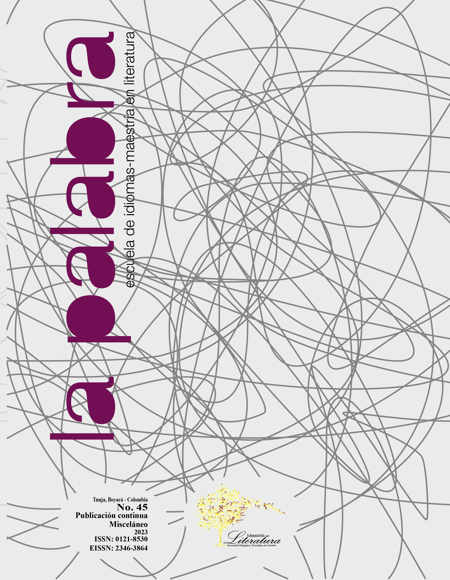Sonances and Dissonances: Listening to the Ukranian Soundscape in the Holodomor Context (1932-1933)

Abstract
The article presents the reconstructed soundscape in the context of the artificial famine (Holodomor) unleashed in Ukraine (1932-1933), this was carried out from the hermeneutic analysis of the testimony published by Miron Dolot, called Execution by Hunger, the Hidden Holocaust. The results of the study show the Bolsheviks altered the sound environment of the victim’s place of residence, during the land collectivization process. They had the purpose of establishing a new pattern of behavior and turning an unknown territory into a recognizable one, and capable of being possessed, in order to give rise to a universal subject, devoid of history, social class and ethnic identity, who will act under the values and ideals promoted by the Soviet socialist society.
Keywords
Soundscape, Holodomor, Sound colonization, Uprooting, Land collectivization
Author Biography
G. Angelica Vasquez Zarate
Sociologist from Universidad Santo Tomás de Colombia. Master in Research in Contemporary Social Problems from the Universidad Central de Colombia. Master in Culture of Peace, Conflict, Education and Human Rights from the Universidad de Cádiz, Spain. Currently, she is a researcher of the group called Contemporary Aesthetic Theories at the niversidad de Cádiz, Spain.
References
- Applebaum, Anne. Hambruna roja: La guerra de Stalin contra Ucrania. Debate, 2019. Impreso.
- Attali, Jacques. Ruidos: ensayo sobre la economía política de la música. Siglo XXI, 1995. Impreso.
- Barka, Vasil. El Príncipe Amarillo. Directmedia Publishing, 2013 [en ucraniano]. Impreso.
- Birdsall, Carolyn. “Earwitnessing: Sound memories of the Nazi period”. Sound Souvenirs: Audio Technologies, Memory and Cultural Practices. 1ed. Ed. José Van Dijck y Karin Bijsterveld. Amsterdam University Press, 2009, pp. 169-181. Impreso.
- Carles, José Luis. “El paisaje sonoro, una herramienta interdisciplinar: análisis, creación y pedagogía con el sonido”. Encuentros iberoamericanos sobre paisajes sonoros. Madrid, junio 12-15, 2007. https://acortar.link/6zaK2O. 12 enero, 2023.
- Carles, José Luis y Sergio Pagan. “Estudio de un paisaje sonoro rural: el caso de Urueña (Valladolid)”. Revista de Folklore, núm. 138, 1992, pp. 195-198. Impreso.
- Chebanyuk, Olena. Ucrania, Estado: palabra folklore. Instituto de Historia de Ucrania, 2018 [en ucraniano]. Impreso.
- Chion, Michel et al. Audiovision. Paidós, 1993. Impreso.
- Dolot, Miron. Execution by Hunger: The Hidden Holocaust. Norton & Company, 1987. Impreso.
- Estévez Trujillo, Mayra. “Suena el capitalismo en el corazón de la selva”. Nómadas, núm. 45, 2016, pp. 13-25. Impreso. DOI: https://doi.org/10.30578/nomadas.n45a1
- Grossman, Vasiliï. Todo fluye. Barcelona, Debolsillo, 2010.
- Glushko, Mijail. Ucrania, Estado: transporte. Ucrania, Instituto de Historia de Ucrania, 2018 [en ucraniano]. Impreso.
- Hernandez, Richard L. “Sacred sound and sacred substance: Church bells and the auditory culture of Russian villages during the Bolshevik Velikii Perelom”. The American Historical Review, núm.109.5, 2004, pp. 1475-1504. Impreso. DOI: https://doi.org/10.1086/530933
- Hughes, James. “Capturing the Russian Peasantry: Stalinist Grain Procurement Policy and the ‘Ural-Siberian Method’”. Slavic Review, núm. 53.1, 1994, pp. 76-103. Impreso. DOI: https://doi.org/10.2307/2500326
- Keyes, Sarah. “Like a Roaring Lion: The Overland Trail as a Sonic Conquest”. Journal of American History, núm. 96.1, 2009,pp. 19-43. Impreso. DOI: https://doi.org/10.2307/27694730
- Kindratyuk, Bohdan. “Belling culture of Kyivan Rus”. Ukrainian Music, núm. 1, 2016, pp. 5-19 [en ucraniano]. Impreso.
- LaBelle, Brandon. Acoustic territories: Sound culture and everyday life. Bloomsbury Publishing, 2010. Impreso.
- López, Juan-Gil. “Soundwalking. Del paseo sonoro ‘in-situ’ a la escucha aumentada”. Un Ruido Secreto, 2012. https://acortar.link/YsR39x .12 de enero, 2023.
- Mishchenko, Maryna Mykolaivna. “Arquetipos nacionales ucranianos: del inconsciente colectivo a la identidad nacional consciente”. Boletín de la Universidad Nacional de Kharkiv, Vicisitudes filosóficas, núm. 51, 2014, pp. 90-94 [en ucraniano]. Impreso.
- Rath, Richard. “Hearing American History”. The Journal of American History, núm. 95.2, 2008, pp. 417-431. Impreso. DOI: https://doi.org/10.2307/25095627
- Ruiz, Ana Lidia. “Ruido: intrusión sonora e intimidad”. Inmediaciones de la Comunicación, núm. 10, 2015, pp. 118-130. Impreso. DOI: https://doi.org/10.18861/ic.2015.10.2589
- Russolo, Luigi. “The art of noises: Futurist manifesto”. Audio culture: Readings in modern music, 2004, pp. 10-14. Impreso.
- Schafer, R. Murray. The soundscape: Our sonic environment and the tuning of the world. Destinity, 1993. Impreso.
- Smith, Bruce. “How sound is sound history? A response to Mark Smith”. Journal of the Historical Society, núm. 23, 2002, pp. 307-315. Impreso. DOI: https://doi.org/10.1111/1540-5923.234024
- Smirnov Andrey y Liubov Pchelkina. Russian Pioneers of Sound Art in the 1920s. Catalogue of the exhibition “Red Cavalry: Creation and Power in Soviet Russia between 1917 and 1945”. La Casa Encendida, 2011. Impreso.
- Serhiychuk, Volodymyr. El Holodomor de 1932-1933 como genocidio de ucranianos. PP Serhichuk MI, 2016 [en ucraniano]. Impreso.
- Sirenko, Serguéi. Ucrania, Estado: clases económicas. Instituto de Historia de Ucrania, 2018 [en ucraniano]. Impreso.
- Siletsky, Roman. Ucrania, Estado: vivienda. Instituto de Historia de Ucrania, 2018 [en ucraniano]. Impreso.
- Stites, Richard. Revolutionary dreams: Utopian vision and experimental life in the Russian revolution. Oxford University Press, 1988. Impreso.
- Stadni︠u ︡ k, Ivan. People are Not Angels. A Barker,1963. Impreso.
- Truax, Barry. Acoustic communication. Greenwood Publishing Group, 2001. Impreso.
- Uspenski, Gleb. El poder de la tierra. Litres, 2017 [en ucraniano]. Impreso.
- Ukrainka, Lesia. Spirit of flame: A Collection of the Works of Lesya Ukrainka. Bookman Associates, 1950. Impreso.
- Volodymyr Lytvyn et al. Historia económica de Ucrania: investigación histórica y económica. Instituto de Historia de Ucrania, 2011. Impreso.
- Vertov, Dziga. Kino-eye: the writings of Dziga Vertov. Univ of California Press, 1984. Impreso.
- Wachtel, Nathan. Los vencidos. Los indios del Perú ante la conquista española. Ceques Editores, 2017. Impreso.
